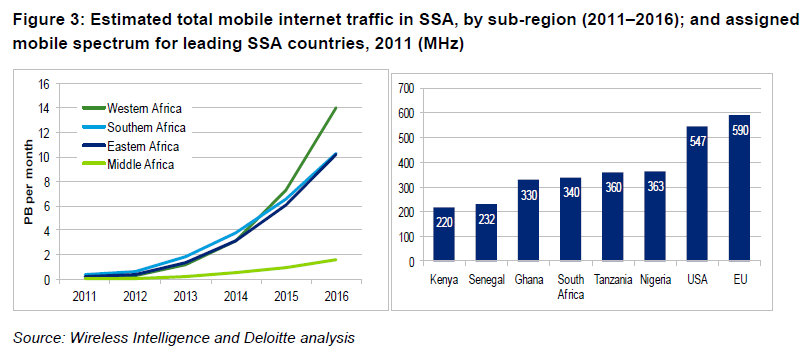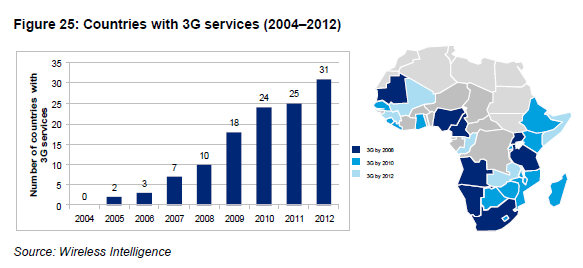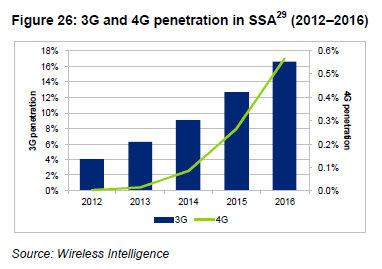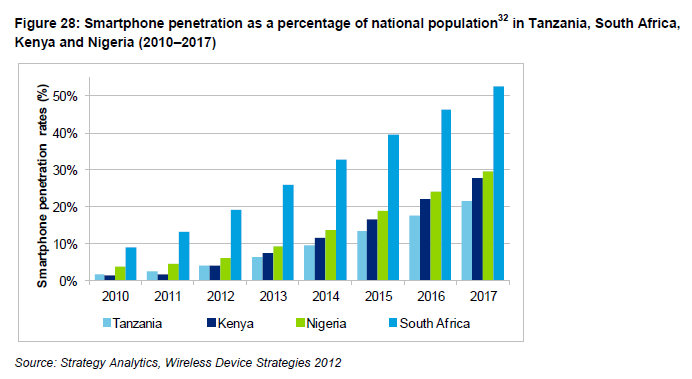Sub-Saharan African mobile Internet growth to accelerate in 2013-2014
Recently, Deloitte (the consultancy) and GSMA (the association of worldwide mobile operators) produced a report on the state of mobile in Sub-Saharan Africa. The gist of the findings is nothing new: the region is experiencing significant economic growth and governments continue to liberalize the telecommunications sector. These two events have, in turn, caused a remarkable growth rate of the mobile market.
The report touts the ability for mobile broadband to provide access in areas far from fixed networks, but laments the lack of spectrum currently available to this technology.
Four charts aptly forecast mobile Internet growth:
1. Mobile Internet traffic is expected to take-off after 2013 for all regions except “Middle Africa” (Central Africa). African spectrum available to mobile Internet is still roughly half that allocated in the USA or EU.
2. As of the year 2012, there are 31 African countries with 3G services – up from 25 a year prior. Licenses have been awarded in many of the other countries, but service has yet to begin.
3. 3G penetration is forecast to grow from 4% in 2012 to over 16% in 2016. In contrast, 4G penetration is anticipated to grow from non-existent to the same 16-17% by 2016. Rapid 4G growth is expected around the year 2014.
4. Smartphone penetration is currently very low, even in mobile markets considered mature by African standards. In five years time, the percentage of Tanzanians, Kenyans, and Nigerians using smartphones is forecast to grow roughly five-fold (from 5% to 20-30%). The majority of South Africans could have access to a smartphone in 2017.
Additionally, the report provides a handful of other important trends:
- 3G penetration levels are forecast to grow by 46% through 2016 per year between 2007 and 2010.
- Some countries allocate only 80MHz for mobile spectrum. Many are between 200-300MHz.
- Spectrum release can increase mobile broadband penetration by 7% across SSA.
- 100% mobile coverage in Burkina Faso and South Africa. 46% mobile coverage in Mali and 50% in Central African Republic.
- There are an average of 3.8 mobile operators per country.
- The number of smartphones sold is forecast to grow on average 40% per year up to 2017.
- A US$50 smartphone will be available in early 2013, along with more dual-SIM devices.
- Mobile broadband adoption will grow as operators expose traditional mobile customers to Internet (ie. Tigo SMS Internet in Tanzania).
- Local content, healthcare services, education services, and e-commerce will further drive mobile broadband adoption.
- Compared to the rest of the world, handsets are cheapest in Africa but, with almost a third of the handset cost composed of taxes, they are taxed at the highest level globally. Airtime taxes apply in many countries as well.
Mobile broadband faces increased costs and reduced coverage unless existing spectrum licenses are liberalized further. Keep a close eye on mobile device/service taxation, regulatory agency intervention, and public-private partnerships.
Source: “Sub-Saharan Africa Mobile Observatory 2012,” Deloitte and GSMA, 13 November 2012.
















 Twitter
Twitter Facebook
Facebook Pinterest
Pinterest
[…] Sub-Saharan African mobile Internet growth to accelerate in 2013-2014 November 26th, 2012 DCA window.setTimeout('window.location="http://dotafrica.mobi/growth-africas-mobile-penetration-slows/"; ',10*60*1000); Recently, Deloitte (the consultancy) and GSMA (the association of worldwide mobile operators) produced a report on the state of mobile in Sub-Saharan Africa. The gist of the findings is nothing new: the region is experiencing significant economic growth and governments continue to liberalize the telecommunications sector. These two events have, in turn, caused a remarkable growth rate of the mobile market. Read More […]